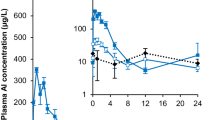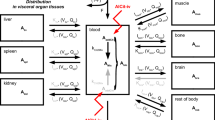Abstract
Aluminium (Al) toxicokinetics after intramuscular (IM) injection of Al-adjuvanted vaccines is unknown. Since animal data are required for modeling and extrapolation, a rat study was conducted measuring Al in plasma and tissues after IM injection of either plain Al-hydroxide (pAH) or Al-phosphate (pAP) adjuvant (Al dose 1.25 mg), single human doses of three Al-adjuvanted vaccines (V1, V2, and V3; Al doses 0.5–0.82 mg), or vehicle (saline). A significant increase in Al plasma levels compared to controls was observed after pAP (AUC(0–80 d), mean ± SD: 2424 ± 496 vs. 1744 ± 508 µg/L*d). Percentage of Al dose released from injected muscle until day 80 was higher after pAP (66.9%) and AP-adjuvanted V3 (85.5%) than after pAH and AH-adjuvanted V1 (0 and 22.3%, resp.). Estimated absolute Al release was highest for pAP (836.8 µg per rat). Al concentration in humerus bone was increased in all groups, again strongest in the pAP group [3.35 ± 0.39 vs. 0.05 ± 0.06 µg/g wet weight (ww)]. Extrapolated amounts in whole skeleton corresponded to 5–12% of the released Al dose. Very low brain Al concentrations were observed in all groups (adjuvant group means 0.14–0.29 µg/g ww; control 0.13 ± 0.04 µg/g ww). The results demonstrate systemically available Al from marketed vaccines in rats being mainly detectable in bone. Al release appears to be faster from AP- than AH-adjuvants. Dose scaling to human adults suggests that increase of Al in plasma and tissues after single vaccinations will be indistinguishable from baseline levels.




Similar content being viewed by others
References
Bagi CM, Berryman E, Moalli MR (2011) Comparative bone anatomy of commonly used laboratory animals: implications for drug discovery. Comp Med 61:76–85
Barak MM, Lieberman DE, Hublin JJ (2013) Of mice, rats and men: trabecular bone architecture in mammals scales to body mass with negative allometry. J Struct Biol 183:123–131
Barrett JS, Della Casa Alberighi O, Läer S, Meibohm B (2012) Physiologically based pharmacokinetic (PBPK) modeling in children. Clin Pharmacol Ther 92:40–49
Brown RP, Delp MD, Lindstedt SL, Rhomberg LR, Beliles RP (1997) Physiological parameter values for physiologically based pharmacokinetic models. Toxicol Ind Health 13:407–484
Crépeaux G, Eidi H, David MO, Tzavara E, Giros B, Exley C, Curmi PA, Shaw CA, Gherardi RK, Cadusseau J (2015) Highly delayed systemic translocation of aluminum-based adjuvant in CD1 mice following intramuscular injections. J Inorg Biochem 152:199–205
FDA/CDER guidance for industry: Estimating the maximum safe starting dose in initial clinical trials for therapeutics in adult healthy volunteers (2005) https://www.fda.gov/downloads/drugs/guidances/ucm078932.pdf. Accessed 13 Sept 2019
Flarend RE, Hem SL, White JL, Elmore D, Suckow MA, Rudy AC, Dandashli EA (1997) In vivo absorption of aluminium-containing vaccine adjuvants using 26Al. Vaccine 15:1314–1318
Gherardi RK, Eidi H, Crépeaux G, Authier FJ, Cadusseau J (2015) Biopersistence and brain translocation of aluminum adjuvants of vaccines. Front Neurol 6:4
He P, Zou Y, Hu Z (2015) Advances in aluminum hydroxide-based adjuvant research and its mechanism. Hum Vaccin Immunother 11:477–488
Hellström HO, Mjöberg B, Mallmin H, Michaëlsson K (2005) The aluminum content of bone increases with age, but is not higher in hip fracture cases with and without dementia compared to controls. Osteoporos Int 16:1982–1988
Hellström HO, Mjöberg B, Mallmin H, Michaëlsson K (2006) No association between the aluminium content of trabecular bone and bone density, mass or size of the proximal femur in elderly men and women. BMC Musculoskelet Disord 7:69
Hem SL, HogenEsch H (2007) Relationship between physical and chemical properties of aluminum-containing adjuvants and immunopotentiation. Expert Rev Vaccines 6:685–698
Hirayama M, Iijima S, Iwashita M, Akiyama S, Takaku Y, Yamazaki M, Omori T, Yumoto S, Shimamura T (2011) Aging effects of major and trace elements in rat bones and their mutual correlations. J Trace Elem Med Biol 25:73–84
HogenEsch H, O’Hagan DT, Fox CB (2018) Optimizing the utilization of aluminum adjuvants in vaccines: you might just get what you want. NPJ Vaccines 3:51
HogenEsch H (2013) Mechanism of immunopotentiation and safety of aluminum adjuvants. Front Immunol 3:406
House E, Esiri M, Forster G, Ince PG, Exley C (2012) Aluminium, iron and copper in human brain tissues donated to the Medical research council’s cognitive function and ageing study. Metallomics 4:56–65
Immunization Safety Review (2001) Thimerosal-containing vaccines and neurodevelopmental disorders. Institute of Medicine (US) Immunization safety Review Committee. National Academies Press (US), Washington
Immunization Safety Review (2004) Vaccines and Autism. Institute of Medicine (US) Immunization safety review committee. Washington (DC): National Academies Press (US)
Klein GL (2019) Aluminum toxicity to bone: A multisystem effect? Osteoporos Sarcopenia 5:2–5
Krewski D, Yokel RA, Nieboer E, Borchelt D, Cohen J, Harry J et al (2007) Human health risk assessment for aluminium, aluminium oxide, and aluminium hydroxide. J Toxicol Environ Health B Crit Rev 10(Suppl 1):1–269
Lin WT, Chen RC, Lu WW, Liu SH, Yang FY (2015) Protective effects of low-intensity pulsed ultrasound on aluminum-induced cerebral damage in Alzheimer’s disease rat model. Sci Rep 5:9671
Lu H, Rosenbaum S (2014) Developmental pharmacokinetics in pediatric populations. J Pediatr Pharmacol Ther 19:262–276
Masson JD, Crépeaux G, Authier FJ, Exley C, Gherardi RK (2018) Critical analysis of reference studies on the toxicokinetics of aluminum-based adjuvants. J Inorg Biochem 181:87–95
Nair AB, Jacob S (2016) A simple practice guide for dose conversion between animals and human. J Basic Clin Pharm 7:27–31
Netterlid E, Hindsén M, Siemund I, Björk J, Werner S, Jacobsson H, Güner N, Bruze M (2013) Does allergen-specific immunotherapy induce contact allergy to aluminium? Acta Derm Venereol 93:50–56
O’Flaherty EJ (1991) Physiologically based models for bone-seeking elements. I. Rat skeletal and bone growth. Toxicol Appl Pharmacol 111:299–312
Ogasawara Y, Sakamoto T, Ishii K, Takahashi H, Tanabe S (2002) Effects of the administration routes and chemical forms of aluminum on aluminum accumulation in rat brain. Biol Trace Elem Res 86:269–278
Ph. Eur. 9.6, Monograph 0153: Vaccines for human use (07/2018)
Powell BS, Andrianov AK, Fusco PC (2015) Polyionic vaccine adjuvants: another look at aluminum salts and polyelectrolytes. Clin Exp Vaccine Res 4:23–45
Priest ND (2004) The biological behaviour and bioavailability of aluminium in man, with special reference to studies employing aluminium-26 as a tracer: review and study update. J Environ Monit 6:375–403
Seeber SJ, White JL, Hem SL (1991) Solubilization of aluminum-containing adjuvants by constituents of interstitial fluid. J Parenter Sci Technol 45:156–159
Shardlow E, Mold M, Exley C (2018) Unraveling the enigma: elucidating the relationship between the physicochemical properties of aluminium-based adjuvants and their immunological mechanisms of action. Allergy Asthma Clin Immunol 14:80. https://doi.org/10.1186/s13223-018-0305-2
Sharma V, McNeill JH (2009) To scale or not to scale: the principles of dose extrapolation. Br J Pharmacol 157:907–921
Steinhausen C (1997) Untersuchung der Aluminiumbiokinetik mit 26Al und Beschleunigermassenspektrometrie. Dissertation, Technical University of Munich, Germany
Sun X, Liu J, Zhuang C, Yang X, Han Y, Shao B et al (2016) Aluminum trichloride induces bone impairment through TGF-β1/Smad signaling pathway. Toxicology 371:49–57
Sun X, Cao Z, Zhang Q, Liu S, Xu F, Che J et al (2015) Aluminum trichloride impairs bone and downregulates Wnt/β-catenin signaling pathway in young growing rats. Food Chem Toxicol 86:154–162
Valtulini S, Macchi C, Ballanti P, Cherel Y, Laval A, Theaker JM, Bak M, Ferretti E, Morvan H (2005) Aluminium hydroxide-induced granulomas in pigs. Vaccine 23:3999–4004
Van Landeghem GF, D’Haese PC, Lamberts LV, Djukanovic L, Pejanovic S, Goodman WG et al (1998) Low serum aluminum values in dialysis patients with increased bone aluminum levels. Clin Nephrol 50:69–76
Veiga M, Bohrer D, Banderó CR, Oliveira SM, do Nascimento PC, Mattiazzi P et al (2013) Accumulation, elimination, and effects of parenteral exposure to aluminum in newborn and adult rats. J Inorg Biochem 128:215–220
Verdier F, Burnett R, Michelet-Habchi C, Moretto P, Fievet-Groyne F, Sauzeat E (2005) Aluminium assay and evaluation of the local reaction at several time points after intramuscular administration of aluminium containing vaccines in the Cynomolgus monkey. Vaccine 23:1359–1367
Walker VR, Sutton RA, Meirav O, Sossi V, Johnson R, Klein J et al (1994) Tissue disposition of 26aluminium in rats measured by accelerator mass spectrometry. Clin Invest Med 17:420–425
Weisser K, Göen T, Oduro JD, Wangorsch G, Hanschmann KMO, Keller-Stanislawski B (2019) Aluminium toxicokinetics after intramuscular, subcutaneous, and intravenous injection of Al citrate solution in rats. Arch Toxicol 93:37–47
Weisser K, Stübler S, Matheis W, Huisinga W (2017) Towards toxicokinetic modelling of aluminium exposure from adjuvants in medicinal products. Regul Toxicol Pharmacol 88:310–321
WHO Expert Committee on Biological Standardization, sixty-sixth report. Geneva: World Health Organization; 2016 (WHO technical report series; no. 999)
WHO (2012) Global advisory committee for vaccine safety“(GACVS), Report of Meeting Held 6–7 June 2012. WHO Weekly Epidemiological Record
Yokel RA, McNamara PJ (2001) Aluminium toxicokinetics: an updated minireview. Pharmacol Toxicol 88:159–167
Yumoto S, Nagai H, Imamura M, Matsuzaki H, Hayashi K, Masuda A et al (1997) 26Al uptake and accumulation in the rat brain. Nucl Instrum Methods Phys Res B 123:279–282
Acknowledgements
The authors thank Barbara Verhoeven for her technical assistance and Daniela Golomb for preparation of the treatment formulations.
Funding
The project was funded by the German Ministry of Health (ZMVI1-2515-FSB-772).
Author information
Authors and Affiliations
Corresponding author
Ethics declarations
Conflict of interest
Author Jennifer D. Oduro declares that she is employee at preclinics GmbH, a contract research organization that has received payment for conducting the animal study. All other authors declare that they have no conflict of interest.
Ethical approval
All applicable international, national institutional guidelines for the care and use of animals were followed. All procedures performed in studies involving animals were in accordance with the ethical standards of the institution (preclinics GmbH, Germany) at which the studies were conducted.
Additional information
Publisher's Note
Springer Nature remains neutral with regard to jurisdictional claims in published maps and institutional affiliations.
Rights and permissions
About this article
Cite this article
Weisser, K., Göen, T., Oduro, J.D. et al. Aluminium in plasma and tissues after intramuscular injection of adjuvanted human vaccines in rats. Arch Toxicol 93, 2787–2796 (2019). https://doi.org/10.1007/s00204-019-02561-z
Received:
Accepted:
Published:
Issue Date:
DOI: https://doi.org/10.1007/s00204-019-02561-z




